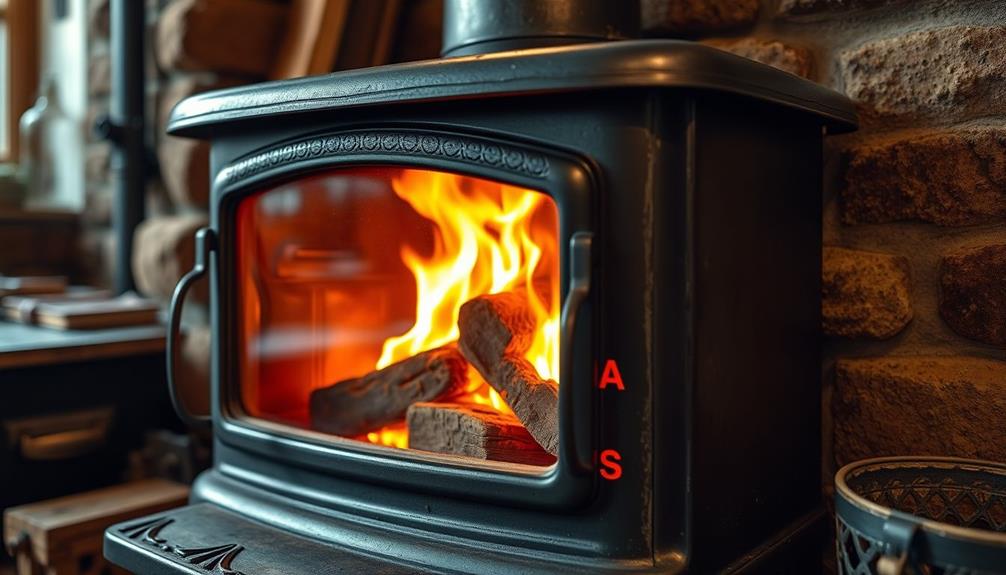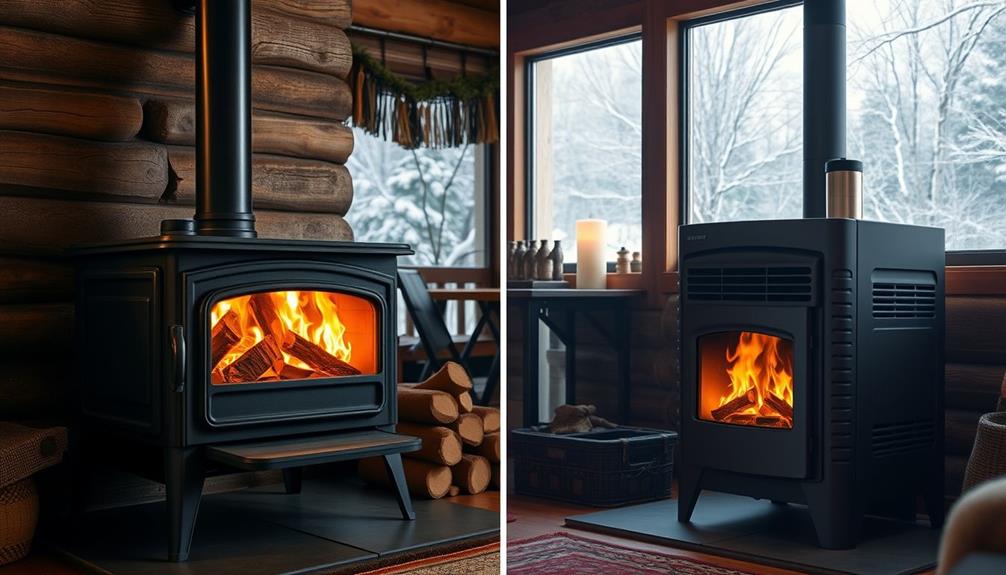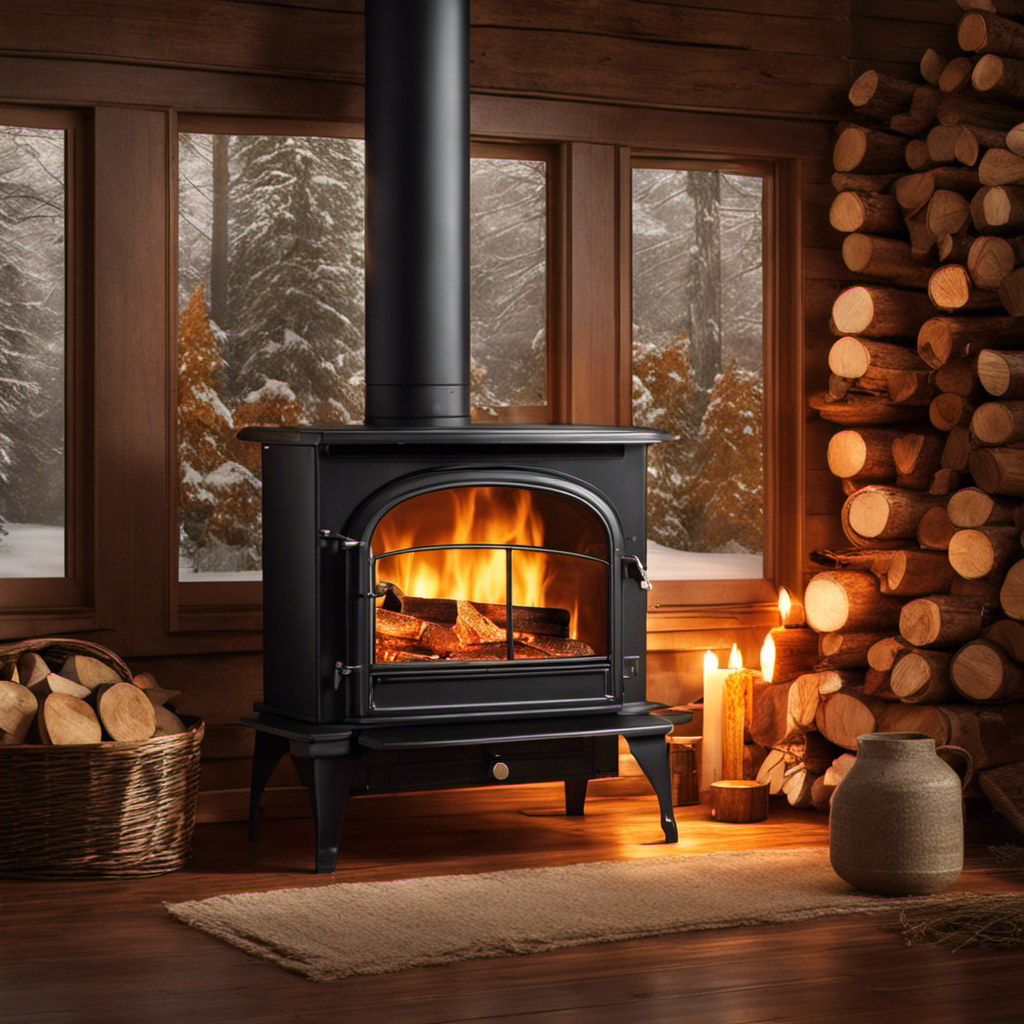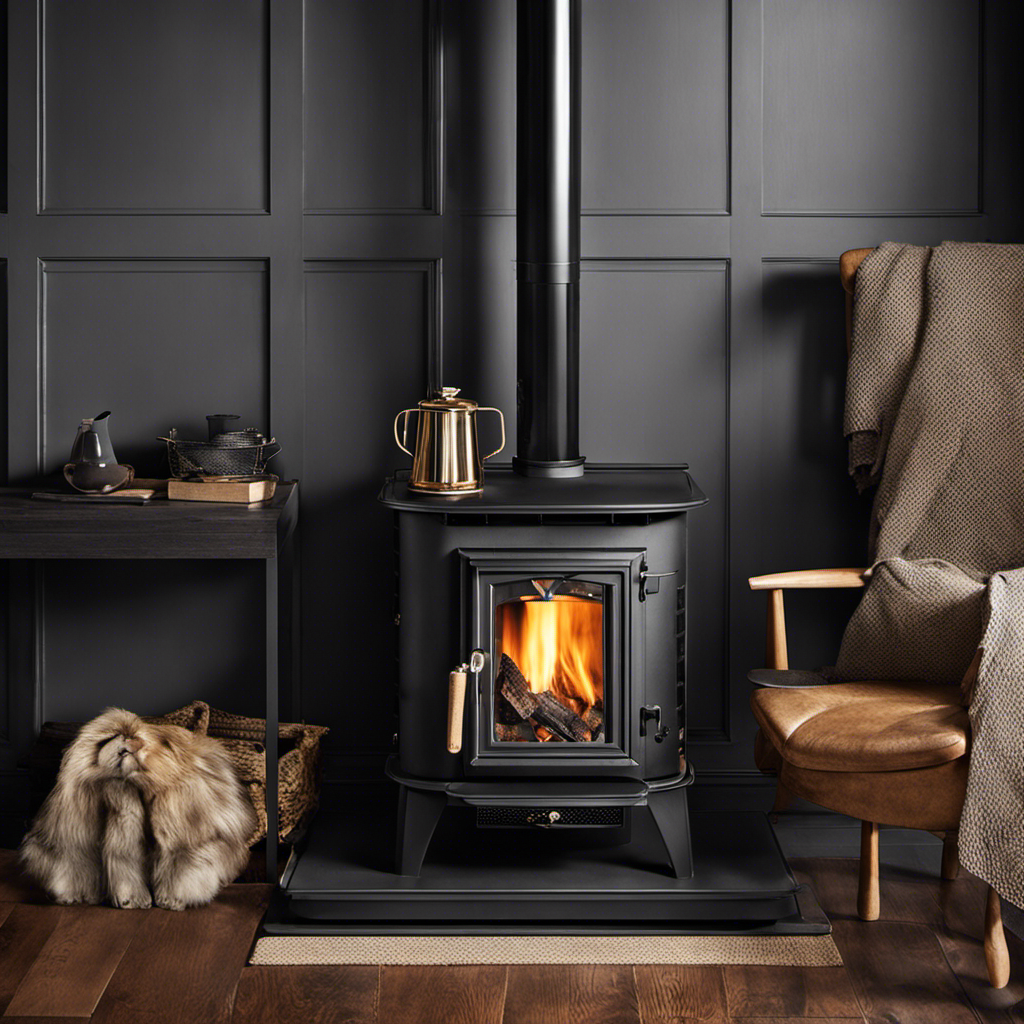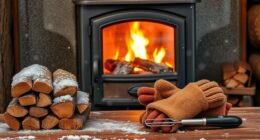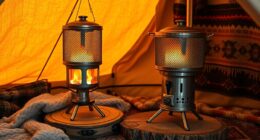Mastering the damper and draft in your wood stove is key to optimizing its performance. Start by using seasoned wood with a moisture content below 20% to improve combustion efficiency. Adjust your damper settings to regulate airflow, keeping flue gas temperatures between 400°F and 500°F for ideal performance. Experiment with different damper types like throat or slider dampers to find what works best for your stove. Regular maintenance is essential; clean your flue to prevent creosote buildup and monitor air control settings based on wood type. There's much more to explore to elevate your wood stove's efficiency and comfort.
Key Takeaways
- Use seasoned wood with moisture content below 20% to enhance combustion efficiency and reduce smoke emissions.
- Regularly adjust air control settings to balance primary and secondary air for cleaner combustion and improved heat output.
- Maintain flue gas temperatures between 400°F and 500°F for optimal combustion and to prevent heat loss.
- Clean the chimney and flue annually to prevent creosote buildup, ensuring consistent draft and airflow.
- Utilize a manometer to accurately gauge and manage draft levels for more efficient wood stove operation.
Understanding Wood Stove Basics
When you're looking to optimize your wood stove's performance, understanding the basics is important. First off, using seasoned wood with a moisture content below 20% greatly boosts combustion efficiency. This type of wood can yield up to 12% more energy than fresh-cut wood, leading to cleaner emissions and better heat output.
Additionally, the choice of wood stove can impact performance; for instance, high-efficiency models like the Englander 10-Cpm can generate substantial heat while using less fuel. You also need to pay attention to air control in your stove. Proper management of air intake influences how effectively your wood burns. The combustion zone should reach a minimum temperature of 600°C (1,100°F) to avoid smoldering, which hampers efficiency. Regularly cleaning your flue is essential to prevent creosote buildup that can obstruct airflow.
Understanding the roles of dampers, particularly the flue damper, is important for regulating air flow and optimizing burn quality. By adjusting these dampers, you can enhance your stove's performance and achieve peak efficiency.
Using high-efficiency stoves that utilize prewarmed combustion air can save you up to 30% in fuel costs compared to older models. By mastering these basic principles, you'll get the most out of your wood stove and enjoy a cozy, efficient fire.
Importance of Draft Control
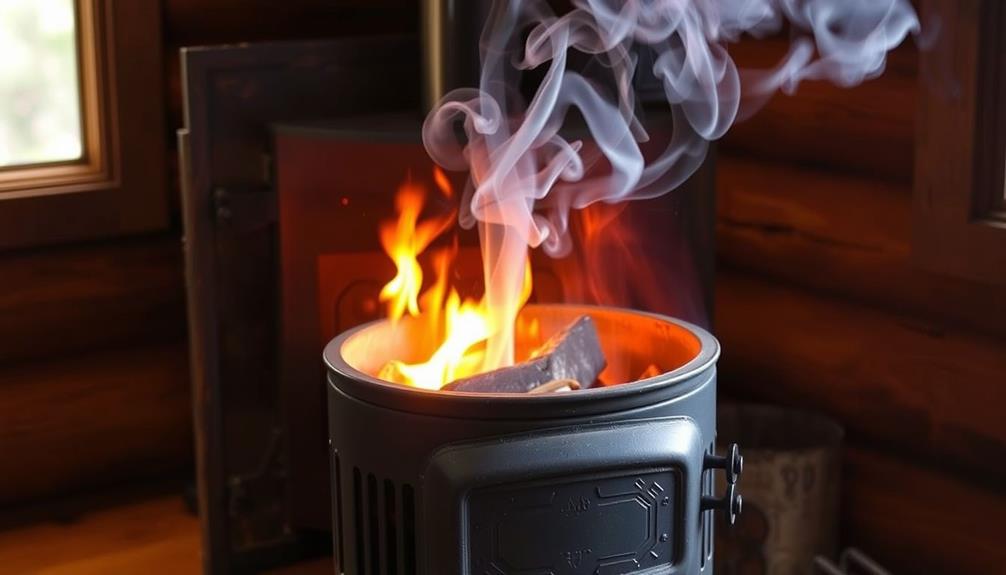
Draft control plays an essential role in your wood stove's efficiency and safety. Proper management of draft notably impacts combustion efficiency, ensuring that your stove burns wood at ideal temperatures. A well-regulated draft allows for consistent air flow, enhancing secondary combustion, which leads to cleaner burns and reduces harmful emissions like carbon monoxide.
Additionally, understanding the principles of thermal energy transfer can help you maximize the heat generated by your stove.
However, it's vital to monitor and adjust your draft carefully. Too much draft can result in heat loss, causing your stove to work harder than necessary. On the flip side, inadequate draft can lead to incomplete combustion, producing smoke that may backflow into your living space, creating a safety hazard.
To achieve the best results, experts recommend maintaining flue gas temperatures between 400°F and 500°F. This range maximizes draft control while minimizing the risk of chimney fires.
You can use tools like manometers to gauge your draft levels accurately, allowing for precise adjustments that enhance your stove's performance.
Types of Dampers
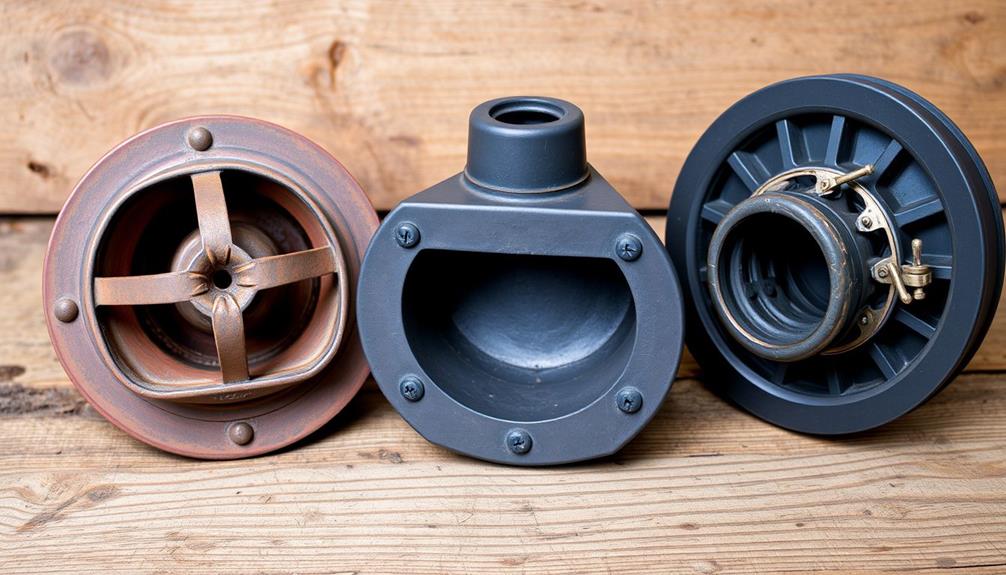
Understanding the various types of dampers can greatly enhance your wood stove's performance. Each damper plays a significant role in managing airflow, guaranteeing efficient combustion, and maintaining heat.
Additionally, optimizing your stove setup can provide benefits akin to the diversification of retirement portfolios by reducing risk exposure from inefficient heating.
Here's a quick overview of the main types of dampers you should know:
- Throat Dampers: Located above the firebox, they regulate airflow in the chimney.
- Top-Sealing Dampers: Installed at the chimney's top, these prevent heat loss when the stove isn't in use.
- Flue Dampers: Control the draft in the stove pipe, improving smoke expulsion and overall combustion efficiency.
- Lower Ash Pan Dampers: Introduce air below the fire for enhanced burn rates.
- Slider Draft Dampers: Manage air above the fire to support secondary combustion.
Understanding these types of dampers is essential for maintaining a balanced air feed.
Properly adjusting your air damper guarantees the right amount of primary air enters for combustion, while secondary air aids in cleaner burning.
This balance prevents issues like glass blackening, ultimately optimizing your wood stove's performance and efficiency.
Optimal Wood Selection
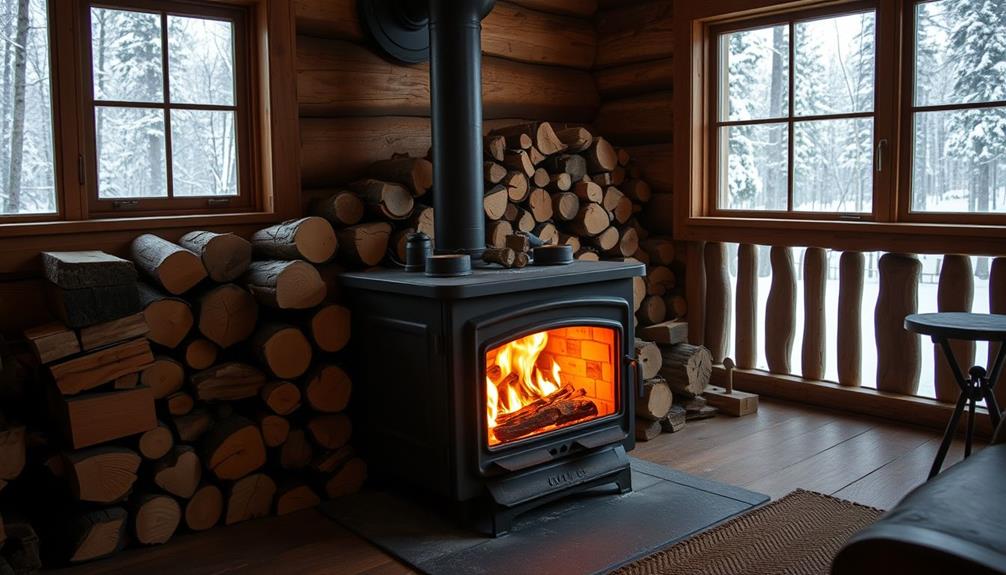
When it comes to fueling your wood stove, the type of wood you choose makes a big difference. Choosing the right wood can't only enhance your stove's efficiency but also contribute to your overall well-being by promoting a mindful lifestyle.
Seasoned wood with a moisture content below 20% not only burns more efficiently but also produces less smoke. You'll find that hardwoods like oak and maple outperform softwoods, giving you more heat and longer burn times.
Holistic lifestyle approach can alleviate menopause symptoms.
Importance of Seasoned Wood
Choosing the right wood for your stove can make all the difference in performance and efficiency. Using seasoned wood—wood that's dried for at least six months—guarantees a moisture content below 20%. This not only boosts heat output but also enhances combustion efficiency.
When you burn properly seasoned wood, you'll enjoy a cleaner burn with less smoke, improving your stove's draft. Additionally, using seasoned wood aligns with eco-friendly practices, similar to the benefits of geothermal energy utilization, which also focuses on reducing emissions.
Here are some key benefits of using seasoned wood:
- Provides 12% more energy than fresh-cut wood
- Reduces smoke production for improved air quality
- Increases overall heat output for better warmth
- Burns longer and hotter, especially hardwoods like oak and maple
- Minimizes harmful emissions, promoting a cleaner environment
Always avoid treated or painted woods, as they can release toxic fumes.
Store your seasoned wood in a sunny, covered area to prevent moisture absorption and guarantee ideal drying conditions. By prioritizing seasoned wood, you'll not only enhance your wood stove's performance but also contribute to a more efficient and eco-friendly heating solution.
Hardwoods Vs. Softwoods
Selecting the right type of wood for your stove is crucial for optimizing heat output and efficiency. Hardwoods and softwoods each have their own strengths and weaknesses that can greatly impact your stove's performance.
Here's a quick comparison:
| Wood Type | Characteristics |
|---|---|
| Hardwoods | Higher density, longer burn times, more heat |
| Softwoods | Quick ignition, higher flames, shorter burn |
| Energy | 12% more energy when seasoned |
| Combustion | Generally cleaner, less smoke/emissions |
| Usage | Mix for balance: hardwoods for longer, softwoods for quick heat |
Hardwoods like oak and maple produce more heat and improve combustion efficiency, contributing to cleaner air quality. They can burn longer and produce less smoke, making them ideal for extended use. On the other hand, softwoods like pine ignite quickly, giving you immediate heat but burn faster, requiring more frequent refueling. If you combine both types, you can enjoy the quick ignition of softwoods while benefiting from the longer-lasting heat of hardwoods. This balanced approach guarantees you maximize the efficiency of your wood stove.
Ideal Moisture Content
Understanding the right type of wood is only part of the equation; achieving the perfect moisture content is just as important for maximizing your wood stove's performance. Properly dried wood should have a moisture content of 20% or lower to guarantee efficient combustion and minimize smoke production.
Here are some tips to help you achieve this:
- Season your wood for at least six months, or ideally one to two years.
- Choose hardwoods like oak or maple, which burn longer and hotter.
- Store your wood in a sunny, covered area to promote ideal drying conditions.
- Check the moisture content using a moisture meter before use.
- Avoid using wood with higher moisture content to prevent incomplete combustion.
Techniques for Efficient Operation
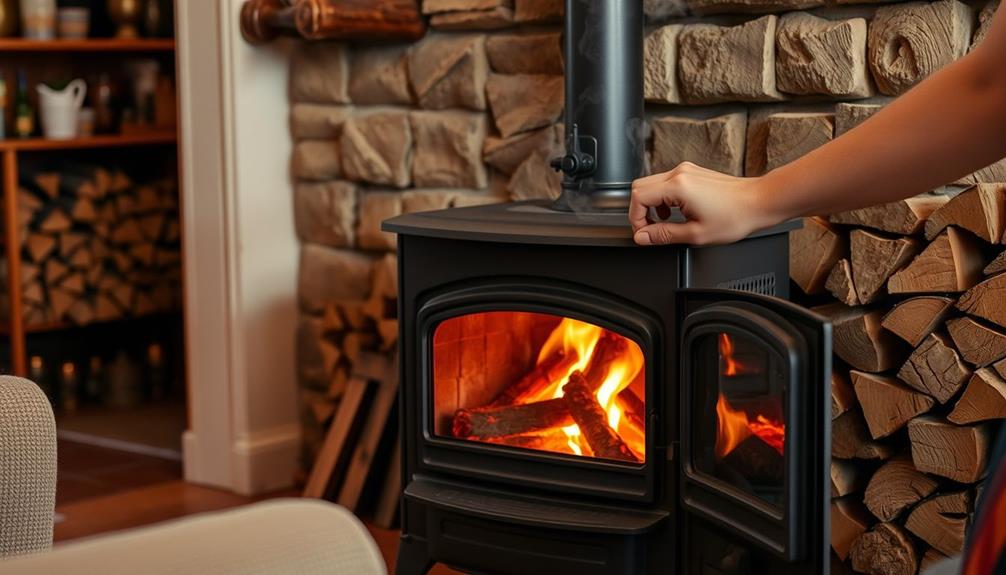
To get the most out of your wood stove, focus on air control strategies, fuel selection, and regular maintenance.
Properly managing clogging remedies can also enhance performance by ensuring your stove operates smoothly without interruptions.
Adjusting the primary air control and choosing seasoned wood can dramatically improve your stove's efficiency.
Air Control Strategies
Effective air control strategies are crucial for maximizing your wood stove's performance and efficiency. Properly managing the damper and air intake can greatly influence your stove's combustion efficiency and heat output. Here are some key techniques to take into account:
– Adjust the damper: A halfway closed damper promotes longer burns, while a fully open damper increases heat quickly.
When reflecting on your wood stove setup, it's also vital to take into account key factors in choosing a home cleaning service for maintaining a clean environment around your stove.
- Balance primary and secondary air: Open primary air for quick ignition but guarantee adequate secondary air to enhance gas combustion for cleaner burns.
- Monitor stovetop temps: Aim for around 500°F to enhance combustion efficiency, as higher firebox temperatures facilitate secondary combustion.
- Use seasoned wood: Choose wood with less than 20% moisture content to prevent hindered heat production and excessive smoke.
- Experiment and adjust: Regularly tweak your air control settings based on external temperatures and draft conditions to achieve peak performance.
Fuel Selection Tips
Selecting the right fuel is vital for maximizing your wood stove's efficiency and heat output. One of the best fuel selection tips is to use seasoned wood with a moisture content below 20%. This can boost your combustion efficiency by up to 12% compared to fresh-cut wood.
When it comes to wood species, hardwoods like oak and maple are superior choices; they burn longer and produce more heat, enhancing your stove's performance. Additionally, just as nutritional benefits of chia seeds can enhance health, choosing the right wood can greatly improve your home's warmth.
Proper stacking of your wood also plays an important role. Stack it tightly for consistent burning, but make certain there's enough space for airflow, as this can greatly impact the burn's efficiency.
Regularly using seasoned wood not only reduces smoke emissions but also helps maintain ideal temperature and conditions in your stove.
Additionally, consider your stove's air control capabilities. Different types of wood may require varying air settings for peak performance. By selecting wood species that match your stove's requirements, you'll further improve your heating experience.
Implement these fuel selection tips to maximize your wood stove's efficiency and enjoy a warmer, more comfortable home.
Regular Maintenance Practices
When it comes to keeping your wood stove running efficiently, regular maintenance practices are key. By focusing on a few essential tasks, you'll enhance your stove's performance and safety.
Understanding the importance of maintaining your equipment is similar to guaranteeing a great camping experience in diverse environments like those found in New England, where seasonal camping opportunities can enhance your adventures.
- Clean the flue and chimney annually to prevent creosote buildup, which can restrict airflow and increase fire risks.
- Lubricate the damper's moving parts to guarantee smooth operation, improving airflow regulation and maintaining a consistent draft.
- Monitor flue gas temperatures; aim for 400-500°F to minimize creosote accumulation and achieve ideal combustion.
- Adjust air control settings based on the wood type. Hardwoods need less air, while softer woods may require more—this helps maintain efficiency.
- Utilize a manometer to measure draft levels, guaranteeing they stay within the manufacturer's recommended range to enhance combustion efficiency and prevent smoke backflow.
Safety Precautions
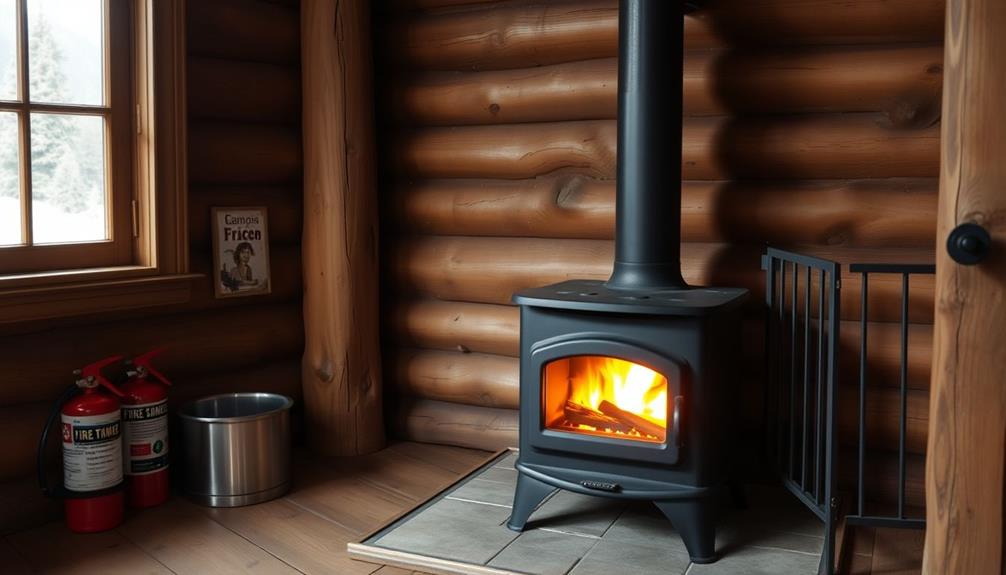
To guarantee a safe and efficient wood stove operation, it's essential to implement important safety precautions. Start by installing smoke and carbon monoxide detectors near your wood stove. This will alert you to any dangerous fumes and help maintain a safe environment. Regularly inspect and clean your chimney to prevent blockages and creosote buildup, which can lead to chimney fires.
Maintain a minimum clearance of 36 inches from combustibles around your wood stove. This distance reduces fire hazards and promotes safe operation. Additionally, consider using a chimney cap to prevent debris, animals, and rain from entering the flue. A chimney cap helps maintain proper ventilation and reduces the risk of blockages that can affect chimney draft.
Familiarize yourself with local regulations regarding wood burning to promote compliance and encourage safe heating practices in your community.
Here's a quick reference table for your safety precautions:
| Safety Precaution | Description | Importance |
|---|---|---|
| Smoke and CO Detectors | Install near the wood stove | Alerts to dangerous fumes |
| Regular Chimney Inspections | Clean to prevent blockages and creosote buildup | Reduces chimney fire risk |
| Clearance from Combustibles | Keep 36 inches from combustibles | Prevents fire hazards |
| Use of Chimney Cap | Prevents debris and animals from entering flue | Maintains proper ventilation |
| Know Local Regulations | Understand local wood burning laws | Promotes compliance |
Maintenance Tips
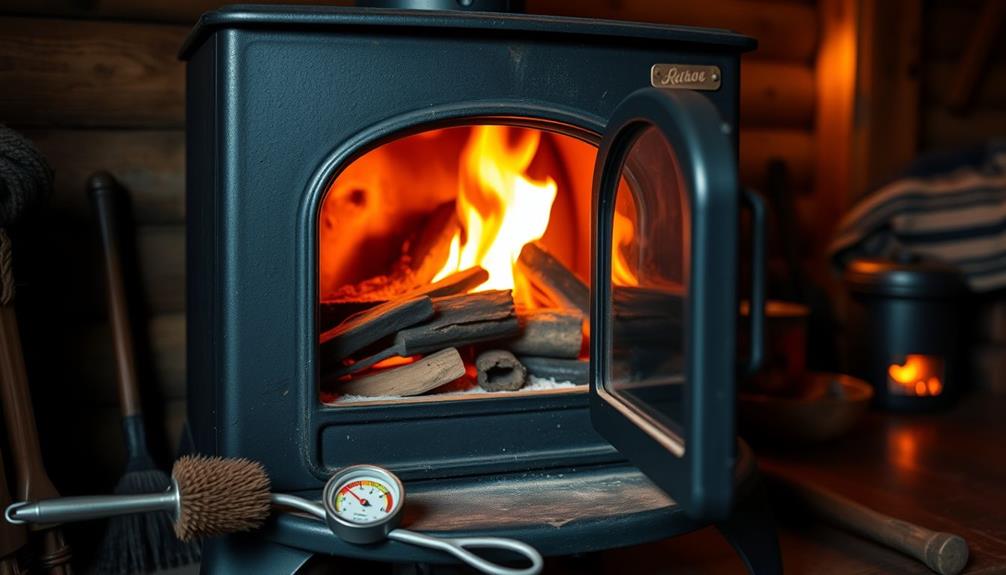
Guaranteeing your wood stove operates efficiently goes hand in hand with proper maintenance. Neglecting maintenance can lead to decreased performance, unsafe conditions, and increased costs.
Here are some vital maintenance tips to keep your wood stove functioning at its best:
- Clean the flue regularly to prevent creosote buildup, which reduces efficiency and poses a fire hazard. Regular cleaning is essential, especially during high usage seasons, to maintain peak performance and safety.
- Inspect and lubricate the damper annually to guarantee smooth operation and prevent rust or wear that can impact airflow. Proper damper function is important for controlling airflow, much like how airflow management is significant for other appliances.
- Monitor indoor climate and ventilation frequently to address any issues that could affect draft performance and air quality.
- Conduct routine checks for blockages or damage in the chimney to maintain peak airflow and avoid backdrafts that disrupt combustion.
- Schedule professional chimney inspections at least once a year to comply with safety standards and identify any potential maintenance needs.
Enhancing Combustion Efficiency
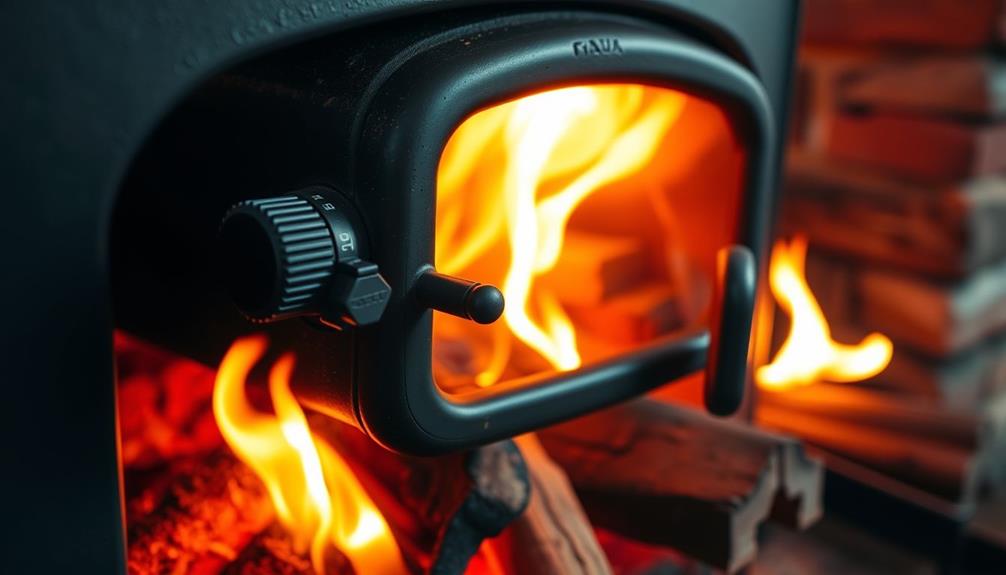
Maximizing your wood stove's combustion efficiency is vital for achieving ideal heat output and reducing emissions. To start, maintain a stovetop temperature around 500°F. This balance guarantees efficient heat production and cleaner burns. Properly seasoned wood, with a moisture content below 20%, plays an important role in achieving complete combustion. Burning wood that's too moist not only creates more smoke but also wastes fuel.
Next, optimize your air control settings. Keeping the primary air damper open until secondary combustion kicks in allows for higher firebox temperatures. This process promotes secondary combustion, effectively burning off gases and enhancing overall burn efficiency. As a result, you'll enjoy longer burn times and reduced fuel consumption.
Regularly monitor your flue gas temperatures and draft levels. High temperatures, ideally between 400-500°F, indicate effective combustion and limit creosote buildup. By maintaining these conditions, you facilitate a more efficient and cleaner burning experience.
Frequently Asked Questions
How to Improve Draft on a Wood Burning Stove?
To improve draft on your wood burning stove, guarantee your chimney's properly sized, use well-seasoned wood, monitor flue gas temperatures, and regularly clean the flue. Adjust air controls based on conditions for peak performance.
How Can You Maximize the Efficiency of a Wood Stove?
Did you know properly seasoned wood can boost your stove's efficiency by up to 30%? To maximize efficiency, use dry wood, monitor temperatures, adjust air dampers, and clean your chimney regularly. You'll enjoy cleaner, hotter fires.
Does Closing the Damper on a Wood Stove Make It Hotter?
Closing the damper can initially make your wood stove hotter by restricting airflow, allowing the fire to burn more efficiently. However, too much closure might lead to incomplete combustion and cooler temperatures over time.
Should I Close the Damper on My Wood Stove at Night?
Like a tight lid on a simmering pot, closing the damper at night can trap heat. You should partially close it, allowing some airflow while keeping an eye on temperatures to avoid smoke and creosote buildup.
Conclusion
By mastering your damper and draft, you're not just optimizing your wood stove's performance, you're enhancing your comfort, conserving fuel, and reducing emissions. You'll enjoy warmer spaces, cleaner air, and a more efficient burn. So, adjust that damper, choose the right wood, and operate with intention. Take charge of your wood stove experience, and let every fire be a demonstration of your skill and knowledge. Let's make each burn cleaner, each flame brighter, and each moment cozier!

